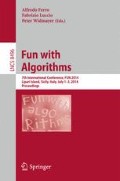Abstract
Given a social network represented by a graph G, we consider the problem of finding a bounded cardinality set of nodes S with the property that the influence spreading from S in G is as large as possible. The dynamics that govern the spread of influence is the following: initially only elements in S are influenced; subsequently at each round, the set of influenced elements is augmented by all nodes in the network that have a sufficiently large number of already influenced neighbors. While it is known that the general problem is hard to solve — even in the approximate sense — we present exact polynomial time algorithms for trees, paths, cycles, and complete graphs.
Access this chapter
Tax calculation will be finalised at checkout
Purchases are for personal use only
Preview
Unable to display preview. Download preview PDF.
References
Ackerman, E., Ben-Zwi, O., Wolfovitz, G.: Combinatorial model and bounds for target set selection. Theoretical Computer Science 411, 4017–4022 (2010)
Alba, J., Hutchinson, J.W., Lynch, J.: Memory and Decision Making. In: Robertson, T.S., Kassarjian, H. (eds.) Handbook of Consumer Behavior (1991)
Aral, S., Walker, D.: Identifying Influential and Susceptible Members of Social Networks. Science 337(6092), 337–341 (2012)
Asch, S.E.: Studies of independence and conformity: A minority of one against a unanimous majority. Psychological Monographs 70 (1956)
Baumeister, R.F., et al.: The need to belong: Desire for interpersonal attachments as a fundamental human motivation. Psychological Bulletin 117(3), 497–529 (1995)
Ben-Zwi, O., Hermelin, D., Lokshtanov, D., Newman, I.: Treewidth governs the complexity of target set selection. Discrete Optimization 8, 87–96 (2011)
Bazgan, C., Chopin, M., Nichterlein, A., Sikora, F.: Parameterized approximability of maximizing the spread of influence in networks. In: Du, D.-Z., Zhang, G. (eds.) COCOON 2013. LNCS, vol. 7936, pp. 543–554. Springer, Heidelberg (2013)
Blair, J.R.S., Goddard, W., Hedetniemi, S.T., Horton, S., Jones, P., Kubicki, G.: On domination and reinforcement numbers in trees. Discrete Mathematics 308(7), 1165–1175 (2008)
Bond, R.M., et al.: A 61-million-person experiment in social influence and political mobilization. Nature 489, 295–298 (2012)
Centeno, C.C., Dourado, M.C., Draque Penso, L., Rautenbach, D., Szwarcfiter, J.L.: Irreversible conversion of graphs. Theoretical Computer Science 412(29), 3693–3700 (2011)
Chen, N.: On the approximability of influence in social networks. SIAM J. Discrete Math. 23, 1400–1415 (2009)
Chen, J., Iver, G., Pazgal, A.: Limited Memory, Categorization and Competition. Marketing Science 29, 650–670 (2010)
Chen, W., Lakshmanan, L.V.S., Castillo, C.: Information and Influence Propagation in Social Networks. Morgan & Claypool (2013)
Chiang, C.Y., et al.: The Target Set Selection Problem on Cycle Permutation Graphs, Generalized Petersen Graphs and Torus Cordalis. arXiv:1112.1313 (2011)
Chopin, M., Nichterlein, A., Niedermeier, R., Weller, M.: Constant thresholds can make target set selection tractable. In: Even, G., Rawitz, D. (eds.) MedAlg 2012. LNCS, vol. 7659, pp. 120–133. Springer, Heidelberg (2012)
Chiang, C.-Y., Huang, L.-H., Li, B.-J., Wu, J., Yeh, H.-G.: Some results on the target set selection problem. Journal of Combinatorial Optimization 25(4), 702–715 (2013)
Chiang, C.-Y., Huang, L.-H., Yeh, H.-G.: Target Set Selection Problem for Honeycomb Networks. SIAM J. Discrete Math. 27(1), 310–328 (2013)
Cicalese, F., Cordasco, G., Gargano, L., Milanič, M., Vaccaro, U.: Latency-Bounded Target Set Selection in Social Networks. In: Bonizzoni, P., Brattka, V., Löwe, B. (eds.) CiE 2013. LNCS, vol. 7921, pp. 65–77. Springer, Heidelberg (2013)
Coja-Oghlan, A., Feige, U., Krivelevich, M., Reichman, D.: Contagious sets in expanders. arXiv:1306.2465
Easley, D., Kleinberg, J.: Networks, Crowds, and Markets: Reasoning About a Highly Connected World. Cambridge University Press (2010)
Flocchini, P., Královic, R., Ruzicka, P., Roncato, A., Santoro, N.: On time versus size for monotone dynamic monopolies in regular topologies. J. Discrete Algorithms 1, 129–150 (2003)
Gargano, L., Hell, P., Peters, J., Vaccaro, U.: Influence diffusion in social networks under time window constraints. In: Moscibroda, T., Rescigno, A.A. (eds.) SIROCCO 2013. LNCS, vol. 8179, pp. 141–152. Springer, Heidelberg (2013)
Kempe, D., Kleinberg, J.M., Tardos, E.: Maximizing the spread of influence through a social network. In: Proc. of the Ninth ACM SIGKDD, pp. 137–146 (2003)
Kempe, D., Kleinberg, J.M., Tardos, É.: Influential Nodes in a Diffusion Model for Social Networks. In: Caires, L., Italiano, G.F., Monteiro, L., Palamidessi, C., Yung, M. (eds.) ICALP 2005. LNCS, vol. 3580, pp. 1127–1138. Springer, Heidelberg (2005)
Leppaniemi, M., Karjaluoto, H., Lehto, H., Goman, A.: Targeting Young Voters in a Political Campaign: Empirical Insights into an Interactive Digital Marketing Campaign in the 2007 Finnish General Election. Journal of Nonprofit & Public Sector Marketing 22, 14–37 (2007)
Nichterlein, A., Niedermeier, R., Uhlmann, J., Weller, M.: On tractable cases of target set selection. Social Network Analysis and Mining (2012)
Peleg, D.: Local majorities, coalitions and monopolies in graphs: a review. Theoretical Computer Science 282, 231–257 (2002)
Reddy, T.V.T., Rangan, C.P.: Variants of spreading messages. J. Graph Algorithms Appl. 15(5), 683–699 (2011)
Surowiecki, J.: The Wisdom of Crowds: Why the Many Are Smarter Than the Few and How Collective Wisdom Shapes Business, Economies, Societies and Nations. Doubleday (2004)
Tumulty, K.: Obama’s Viral Marketing Campaign. TIME Magazine (July 5, 2007)
Zaker, M.: On dynamic monopolies of graphs with general thresholds. Discrete Mathematics 312(6), 1136–1143 (2012)
Author information
Authors and Affiliations
Editor information
Editors and Affiliations
Rights and permissions
Copyright information
© 2014 Springer International Publishing Switzerland
About this paper
Cite this paper
Cicalese, F., Cordasco, G., Gargano, L., Milanič, M., Peters, J.G., Vaccaro, U. (2014). How to go Viral: Cheaply and Quickly. In: Ferro, A., Luccio, F., Widmayer, P. (eds) Fun with Algorithms. FUN 2014. Lecture Notes in Computer Science, vol 8496. Springer, Cham. https://doi.org/10.1007/978-3-319-07890-8_9
Download citation
DOI: https://doi.org/10.1007/978-3-319-07890-8_9
Publisher Name: Springer, Cham
Print ISBN: 978-3-319-07889-2
Online ISBN: 978-3-319-07890-8
eBook Packages: Computer ScienceComputer Science (R0)

